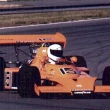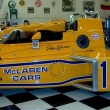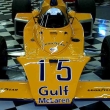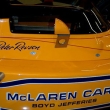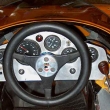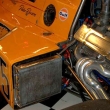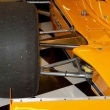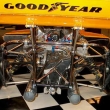1973 McLaren M16-C
Team McLaren competed in their first Indianapolis races in 1969. The M15 was the first McLaren Indy car designed by Gordon Coppuck, based on the team’s Can-Am experiences. McLaren stuck to their usual race winning methods of testing and re-testing a car until it was not only good but extremely reliable, and within a few months McLaren looked like they could have another winner. Then disaster struck. In a practice session, the fuel cap on Hulme’s car popped open, releasing burning methanol all over driver and car. Hulme’s hands were badly burnt and he was unable to drive for quite awhile. Things then got worse. On June 2, 1970, Bruce McLaren was killed while testing an M8D Can-Am car at Goodwood. The team decided to deal with this tragic loss by continuing to race in all the major races on the USAC calendar. The M15 performed well but it was soon time to look forward to the new season and design a car based on what Team McLaren had learned in their first year at Indy.
The M16 series was initiated in September 1970 and first revealed to the press, ready to race, in January 1971 at Team headquarters in Colnbrook, England. The M16 was designed by Coppuck who drew inspiration from the pioneering wedge shaped Lotus Type 72 Formula 1 car. He believed this car would be good for oval races as the forces applied to the car are a lot more constant than Formula 1 with only 60 mph speed difference between corners and straights. The shape was ideal for continuous running but it gave a high level of downthrust at the front which had to be balanced by a large wing at the back. The tapering monocoque meant the M16 had to have its radiators situated in the middle of the car, alongside the drivers hips. It also meant the engine was slung semi-stressed into the monocoque’s rear and steadied by tubular A frames on either side. The fuel was stored in the center of the wheelbase to promote lower polar movement. Although two speed transmission is normal at Indy, McLaren decided on a Hewland LG500 three speed as it gave better acceleration.
McLaren built three M16Cs for the 1973 Indianapolis season. The M16C had changed very little from the original M16 apart from the addition of an engine cover to smooth airflow back onto the rear wing. The car loved the fast, open circuits and was very stable at high speeds. The M16C’s debut began an unparalleled success at the Indy 500.
The M16C-2 in the Mathews Collection became Peter Revson’s McLaren Team car after he crashed his own chassis at the Indy 500 in 1973. While driving it, he qualified on the pole at both Pocono and Ontario. McLaren, as was their standard practice, sold the car to a privateer, Salt Walther at the end of the 1973 season. Walter raced it through 1974 and 1975 and then it went to David Hobbs in 1976. Jerry Karl purchased the M16C-2 in 1978 as a backup car, converted it to a stock block Chevy V8 and raced in the 1980 Indy where it placed 21st. Karl ran again at Indy in 1982. Although the M16C-2 was the oldest McLaren in the field, it still managed a respectable 15th place finish.

